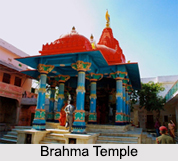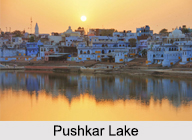 Located to the northwest of Ajmer, the tranquil city of Pushkar is an important centre of pilgrimage for Hindus. Situated at an elevation of 510 m, Pushkar is surrounded by hillocks on all three sides and is known to be one of the oldest towns of India. The city has an interesting mythological history with a legacy of timeless architectural heritage making Pushkar a popular tourist attraction. Discussed elaborately below are some of the fascinating places which facilitate tourism in Pushkar.
Located to the northwest of Ajmer, the tranquil city of Pushkar is an important centre of pilgrimage for Hindus. Situated at an elevation of 510 m, Pushkar is surrounded by hillocks on all three sides and is known to be one of the oldest towns of India. The city has an interesting mythological history with a legacy of timeless architectural heritage making Pushkar a popular tourist attraction. Discussed elaborately below are some of the fascinating places which facilitate tourism in Pushkar.
Brahma Temple: A rare religious site dedicated to the Lord of Creation, Lord Brahma, and the temple is known to be one of the very few existing temples of the Hindu God in India. The temple is located close to the sacred Pushkar Lake and the origin of it is a bit vague, some saying the structure dates back to 2000 years old. Although the current structure dates back to the 14th century and is made up of marble and stone. The Brahma Temple also known as the Jagatpita Brahma Mandir has a unique architecture along with the majestic red pinnacle and the bird motif of the sacred structure gives it a distinctive identity. Inside the place of worship, images of Brahma adorn the sanctum sanctorum. Married men are not allowed entry into the sanctum sanctorum as this place is reserved only for ascetics or sanyasis. Dedicated to Lord Brahma, the most important festival is held here during the months of October and November and devotees throng to this place.
Varaha Temple: A Vaishnava temple and is one of the largest and ancient temples of Pushkar, the Varaha Temple is dedicated to Varaha, the third incarnation of Lord Vishnu. Legend has it that Varaha rescued the earth from depth of the primeval water, where it was dragged down by a demon named Hirnayaksh. The temple was built in 12th century by King Anaji Chauhan but was later destroyed by the Mughal Emperor Aurangzeb. In the 18th century, the temple was again reconstructed by Raja Sawai Man Singh of Jaipur. Currently, it is one of the most visited temples in Pushkar.
 Pushkar Lake: Created by building a dam, this artificial lake lies nestled in the folds of the Aravalli Range and is surrounded by a desert and hills on all sides. The Pushkar Lake is one of the most prominent spots of pilgrimage as well as the site of the world famous Pushkar Fair. According to legends, it is said that a lotus fell from the hands of Lord Brahma, thus creating the Pushkar Lake, which makes the lake as old as creation itself. Hindu mythology speaks about Panch Sarovars or the 5 Lakes – Man Sarovar, Bindu Sarovar, Narayan Sarovar, Pampa Sarovar and Pushkar Sarovar, of which, Pushkar Lake is considered to be the most sacred.
Pushkar Lake: Created by building a dam, this artificial lake lies nestled in the folds of the Aravalli Range and is surrounded by a desert and hills on all sides. The Pushkar Lake is one of the most prominent spots of pilgrimage as well as the site of the world famous Pushkar Fair. According to legends, it is said that a lotus fell from the hands of Lord Brahma, thus creating the Pushkar Lake, which makes the lake as old as creation itself. Hindu mythology speaks about Panch Sarovars or the 5 Lakes – Man Sarovar, Bindu Sarovar, Narayan Sarovar, Pampa Sarovar and Pushkar Sarovar, of which, Pushkar Lake is considered to be the most sacred.
Devotees believe that between the months of October and November, during Kartik Poornima, bathing in the waters of the lake, which is believed to possess special medicinal properties, would absolve sins and cure all skin diseases. It is at this time that the Pushkar Fair is held, which wonderfully exhibits the vibrancy of Rajasthan with exotic colours, dishes, dance, cattle fair and numerous entertaining contests and competitions. The lake is known to be surrounded by 52 bathing ghats and has over 500 Hindu temples situated around the lake precincts.
Gurudwara Singh Sabha: Built in the beginning of the 19th century, the Gurudwara Singh Sabha was constructed to commemorate the visits of the first and tenth gurus, Guru Nanak Dev and Guru Govind Singhji. The gurus visited Pushkar during their travels to the Rajputana states in 1706, where they were served by a priest named Chetan Das. The place where Guru Govind Singhji stayed was known as Govind Ghat which has now been renamed to Gandhi Ghat. There is a stone slab inscribed as Gobind Ghat under a kiosk in four different scripts i.e. Devanagari, Gurumukhi, Persian and Roman. There is a hukamnama inscribed on bhojpatra which states that it was presented to priest Chetan Das by Guru Gobind Singh, which is still in possession of the serving priest here now. The main priest also possesses a handwritten copy of Guru Granth Sahib – the religious scripture of Sikhism.
Savitri Temple: Dedicated to Lord Brahma`s first wife, Goddess Savitri, the Savitri temple is situated on a hillock right behind the Brahma temple. The temple houses the idols of both the wives of Lord Brahma named Savitri and Gayatri. It is said that the presence of the only Brahma Temple in Pushkar is the outcome of Savitri"s curse to Brahma for marrying another Goddess named Gayatri. The temple is situated at an elevation of 750 ft and thus the climb to the temple is strenuous with a long winding series of steps.
 Rangji Temple: The gracious and conspicuous Rangji Temple is another popular shrine that witnesses thousands of pilgrims and tourists every year. The temple is dedicated to Lord Rangji, believed to be an incarnation of Lord Vishnu. The influence of South Indian style, Rajput style and Mughal style in the temple"s architecture is highly noticeable. The high-rising Gopuram, which is prevalent mainly in the temples present in South India, is another feature of the temple that attracts visitors.
Rangji Temple: The gracious and conspicuous Rangji Temple is another popular shrine that witnesses thousands of pilgrims and tourists every year. The temple is dedicated to Lord Rangji, believed to be an incarnation of Lord Vishnu. The influence of South Indian style, Rajput style and Mughal style in the temple"s architecture is highly noticeable. The high-rising Gopuram, which is prevalent mainly in the temples present in South India, is another feature of the temple that attracts visitors.
Pap Mochini Temple: Located in the northern part of Pushkar, the Pap Mochini Temple is like a pearl in the crown of Pushkar. Presided by the deity Ekadashi Mata, the temple is believed to provide respite to followers from their cardinal sins. Having a great spiritual importance as well as boasting a splendid architecture, the Pap Mochini Temple is one of the most popular temples in Rajasthan and one of the famous tourist attractions.
Man Mahal: The largest royal place of residence in Pushkar, Man Mahal is located beside the Sarovar Lake and was built as a guest house for Raja Man Singh I. The Rajasthani architecture from the ancient era that adorns the palace makes it a visual treat. The palace has now been converted into a heritage hotel, called the RTDC Hotel Sarovar, which allows tourists to not only enjoy the beauty of the palace but also the breathtaking view of the lakes and temples around the place.
 Atmateshwar Temple: This beautiful 12th century temple is dedicated to Lord Shiva and has an underground component. The intricate Hemadpanti architectural style carvings give the Atmateshwar Temple a magnificent appearance. Thousands of devotees flock here to pay their respect during the auspicious time of Shivaratri, when Lord Shiva is ritually respected.
Atmateshwar Temple: This beautiful 12th century temple is dedicated to Lord Shiva and has an underground component. The intricate Hemadpanti architectural style carvings give the Atmateshwar Temple a magnificent appearance. Thousands of devotees flock here to pay their respect during the auspicious time of Shivaratri, when Lord Shiva is ritually respected.
Pushkar is among the four dhams or popular pilgrimage sites in India and tourism here is quite popular as devotees and tourists flock to this place all year round.



















